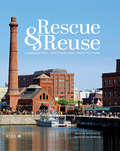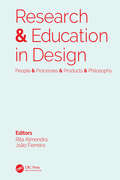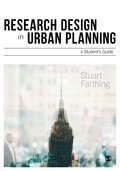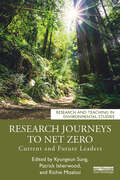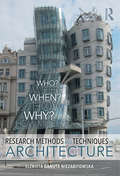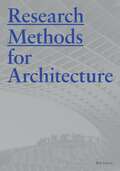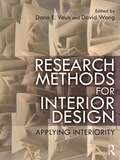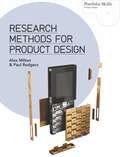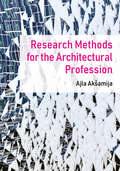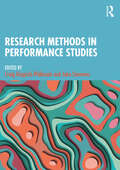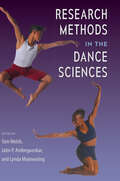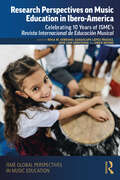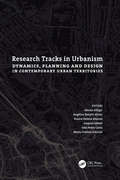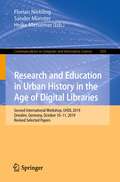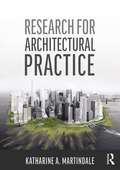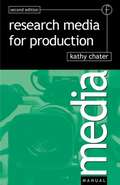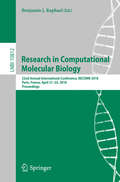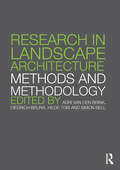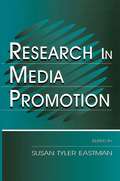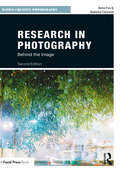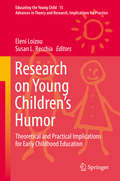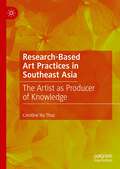- Table View
- List View
Rescue and Reuse: Communities, Heritage and Architecture
by Ian Morrison Merlin WatersonHistoric buildings and places play an essential role in the everyday lives of the people of the UK, their cultural identity and the economy. They can inspire creativity and enterprise, bring communities together, and make people happier about where they live. This book explores how historic buildings across the UK have been brought back to life through the technical and enabling skills, creativity and sensitivity of architects. Exemplar projects explored through richly illustrated case studies demonstrate the value to society of re-using historic buildings and will inspire a new generation of architects to get involved with community heritage projects at a time of great opportunity. Drawing on interviews with architects and their community clients, this book explores the challenges that they face, how they are overcome, and the benefits that follow.
Rescue, Restore, Redecorate: Amy Howard's Guide to Refinishing Furniture and Accessories
by Amy Howard“[The] step-by-step instructions are clear and practically foolproof . . . an essential guide to DIY restoration and antiquing.” ?Publishers Weekly (starred review)Whether you dream of restoring an heirloom to its former beauty, or just want to modernize a flea market treasure, Amy Howard has the design and refinishing secrets you need. Here are all the furniture finishing recipes, techniques, and tips that have made Howard’s beloved classes sold-out success stories, and made Howard herself the go-to guru of refinishing and “use what you have” redecorating. Try your hand at unique painted and faux finishes, and experiment with gold leaf, distressing, and marvelous graining effects. Along the way, you will learn a treasure trove of techniques, as Howard shares before-and-after makeovers from her studio and offers impeccable step-by-step instruction in all that is needed to achieve each look.
Research & Education in Design: Proceedings of the 1st International Conference on Research and Education in Design (REDES 2019), November 14-15, 2019, Lisbon, Portugal
by Rita AlmendraDesign is about the creation of meaningful connections to solve problems and advance human wellbeing; the discipline has always explored the beneficial links between form and function, technology and meaning, beauty and utility, people and artefacts and problems and solutions, among others. This book focuses on the crucial connection between design research and design education. Contemporary society grows increasingly hyper-complex and globally competitive. This state of affairs raises fundamental questions for both Design Education and Design Research: Should research skills be integrated into undergraduate courses? How can we modify design courses without compromising the positive aspects of the educational studio experience? Can the three cycles of higher education in design be combined into a creative and inquisitive educational continuum? To examine the relationship between research and education in Design we must address the topic of knowledge, keeping in mind that the development and dissemination of new and useful knowledge is the core purpose of a University. If we agree that design has its own things to know and ways to find out about them, then design knowledge resides in people, processes, products, and philosophy. This book explores the intersection of these four areas with the aim of uncovering insights to advance the current state of the design discipline.
Research Design in Urban Planning: A Student′s Guide
by Stuart Farthing"This excellent book fills a significant gap in the literature supporting planning education by providing clear, succinct advice on the design and implementation of small-scale student research projects." - Chris Couch, Professor of Geography and Planning, University of Liverpool "A perfect text for supervisors to give students so that they plan their research projects carefully rather than leap headlong into data collection." - Jean Hillier, Emeritus Professor of Sustainability and Urban Planning, RMIT University, Melbourne "Highly recommended... Ranging across topics such as planning a research programme and data management and the handling of ethical issues, the book will be very helpful to those embarking on a thesis or dissertation in the field." - Peter Fidler, President of the University of Sunderland Research Design in Urban Planning: A Student’s Guide is a brilliantly accessible guide to designing research for that all-important dissertation. Aimed at both undergraduate and postgraduate levels, this text will: · discuss research design, outlining the stages of the research process in clear detail and the key decisions which need to be taken at each stage · explain to students how to re-interpret policy issues as researchable questions, appropriate for investigation · look in detail at how researchers make their choice of methods, helping students to justify their own decisions · reveal the ethical dimension to such decisions in the context of a growing requirement for the ethical approval of student projects · review the issues for comparative studies – important not least because of student involvement in Erasmus programs and AESOP workshops Packed with case studies, exercises, illustrations and summaries, Research Design in Urban Planning is an invaluable resource for students undertaking their first substantial, individual investigations.
Research Journeys to Net Zero: Current and Future Leaders (Research and Teaching in Environmental Studies)
by Richie Moalosi Kyungeun Sung Patrick IsherwoodThis book provides useful insight into how academics from diverse disciplinary backgrounds, such as science, engineering, technology, social science, policy, design, architecture, built environment, business, and management, have been conducting research into how to realise net zero emissions to address climate change. This book explores the ways in which countries around the world have pledged to achieve net zero emissions through decarbonisation processes. It presents the highest calibre research and impact activities carried out in the UK, Europe, North America, Australia, Asia, and Africa. Such activities include conceptualisation, opportunity identification, specific case studies, demonstration of proof of concepts, provision of evidence, education of the general public, and knowledge transfer to companies. Further to this, the chapters also bring to light personal career journeys to net zero by current and future international research leaders. From this book, readers will gain a full understanding of net zero research via multiple disciplinary pathways, be inspired by personal accounts, and will learn key methodologies, including quantitative and qualitative approaches. The diversity of authors and topics make the book widely applicable to a range of fields, and it will be of great interest to researchers, students, practitioners, and decision makers working towards the goals of net zero and decarbonisation.
Research Methods and Techniques in Architecture
by Elzbieta Danuta NiezabitowskaA scientific approach to architectural and architectonic research from the scope of just one discipline is no longer sufficient. With contemporary considerations such as behavior, health, and environmental protection, architects and students alike need holistic research methodologies that incorporate qualitative elements as well as more traditional quantitative ones. <P><P>Research Methods and Techniques in Architecture examines research methodologies and tools applied in science and architectonic practice. Beginning with a thorough introduction to the main scientific, environmental, and architectural theories of the late twentieth century, the book guides the reader through the different aspects of architectural research design, building research teams, choosing applicable research methods, and representing research results.
Research Methods for Architecture
by Ray LucasWhile fundamentally a design discipline, architectural education requires an element of history and theory, grouped under the term ‘research’. However, many students struggle with this part of their course. This practical handbook provides the necessary grounding in this subject, addressing essential questions about what research in architecture can be.The first part of the book is a general guide to the fundamentals of how to do research, from assembling a literature review to conducting an interview. The second section presents a selection of case studies dealing with such topics as environmental psychology, the politics of space, ethnographic research and mapping.
Research Methods for Architecture
by Ray Lucas Raymond LucasWhile fundamentally a design discipline, architectural education requires an element of history and theory, grouped under the term ‘research’. However, many students struggle with this part of their course. This practical handbook provides the necessary grounding in this subject, addressing essential questions about what research in architecture can be.The first part of the book is a general guide to the fundamentals of how to do research, from assembling a literature review to conducting an interview. The second section presents a selection of case studies dealing with such topics as environmental psychology, the politics of space, ethnographic research and mapping.
Research Methods for Interior Design: Applying Interiority
by Dana E. VauxInterior design has shifted significantly in the past fifty years from a focus on home decoration within family and consumer sciences to a focus on the impact of health and safety within the interior environment. This shift has called for a deeper focus in evidence-based research for interior design education and practice. Research Methods for Interior Design provides a broad range of qualitative and quantitative examples, each highlighted as a case of interior design research. Each chapter is supplemented with an in-depth introduction, additional questions, suggested exercises, and additional research references. The book’s subtitle, Applying Interiority, identifies one reason why the field of interior design is expanding, namely, all people wish to achieve a subjective sense of well-being within built environments, even when those environments are not defined by walls. The chapters of this book exemplify different ways to comprehend interiority through clearly defined research methodologies. This book is a significant resource for interior design students, educators, and researchers in providing them with an expanded vision of what interior design research can encompass.
Research Methods for Product Design (Portfolio Skills)
by Paul Rodgers Alex MiltonThis book provides the reader with a comprehensive, relevant, and visually rich insight into the world of research methods specifically aimed at product designers. It includes practical case studies and tutorials that will inform, inspire and help you to conduct product design research better. Product designers need a comprehensive understanding of research methods as their day-to-day work routinely involves them observing people, asking questions, searching for information, making and testing ideas, and ultimately generating 'solutions' to 'problems'. Manifest in the design process is the act of research. Huge technological advances in information, computing and manufacturing processes also offer enormous opportunities to product designers such as the development of 'intelligent' products and services, but at the same time raise important research questions that need to be dealt with. Product designers are, in many ways, best placed to address these challenges because of the manner in which they apply their design thinking to problems. This book demonstrates in a clear, highly visual and structured fashion how research methods can support product designers and help them address the very real issues the world currently faces in the 21st century.
Research Methods for Product Design (Portfolio Skills)
by Paul Rodgers Alex MiltonThis book provides the reader with a comprehensive, relevant, and visually rich insight into the world of research methods specifically aimed at product designers. It includes practical case studies and tutorials that will inform, inspire and help you to conduct product design research better. Product designers need a comprehensive understanding of research methods as their day-to-day work routinely involves them observing people, asking questions, searching for information, making and testing ideas, and ultimately generating 'solutions' to 'problems'. Manifest in the design process is the act of research. Huge technological advances in information, computing and manufacturing processes also offer enormous opportunities to product designers such as the development of 'intelligent' products and services, but at the same time raise important research questions that need to be dealt with. Product designers are, in many ways, best placed to address these challenges because of the manner in which they apply their design thinking to problems. This book demonstrates in a clear, highly visual and structured fashion how research methods can support product designers and help them address the very real issues the world currently faces in the 21st century.
Research Methods for the Architectural Profession
by Ajla AksamijaResearch Methods for the Architectural Profession introduces research as a systematic process, describes how to formulate research questions, provides an in-depth explanation of different research methods (qualitative, quantitative, and experimental), and explains how to select appropriate research methods and execute research studies. It describes the process of documentation, knowledge dissemination, and application of research results in architectural design and practice. Most importantly, it provides guidelines for integrating research into profession and uses extensive case-studies and practice-relevant examples to illustrate main concepts, procedures, and applications. Integrating research into practice is essential for developing new knowledge, solving design and technical problems, overcoming different types of challenges present in the contemporary profession, and improving the design outcomes. Innovation requires a much stronger correlation between research and design, and it is pertinent for the future of architectural practice that research becomes an integral part of architectural profession. This book provides a roadmap for successfully integrating research into architectural design and for establishing innovative practices, regardless of a firm’s size. Written by an architecture professor with an extensive research and professional background—specifically focusing on integrating research into practice—and richly illustrated with over 150 color images, this reference will be useful for both students and practitioners.
Research Methods in Performance Studies
by Craig Gingrich-Philbrook Jake SimmonsResearch Methods in Performance Studies offers a unique approach for readers to engage with performance research and methods in practice. It examines ways of making performance, researching performance cultures, researching performers who themselves are engaged in research, and conducting research in the context of enduring and emergent themes of performance studies inquiry. This book features the work of eighteen scholar-artists currently working in performance studies who demonstrate—through applied projects—various methods for conducting performance research. The result is a wide array of novel scholarship including activist performance, slam poetry, video performance, stand-up comedy, adaptation for the Broadway stage, naturecultural performance, intersectional performance, performances of cultural and material preservation, and many others. Faculty, undergraduate and graduate students, and performance practitioners alike will benefit from the approaches to performance studies research methods articulated by the scholar-artists featured in this collection.
Research Methods in the Dance Sciences
by Tom Welsh, Jatin P. Ambegaonkar, and Lynda MainwaringA comprehensive guide to conducting empirical research in dance Research Methods in the Dance Sciences introduces concepts and practices that support effective, empirical research in the dance sciences, including medical science. A valuable new resource for this growing field, this book provides foundational knowledge for anyone who wants to understand, apply, and conduct research with dancers and proposes ways to facilitate more collaboration between the many disciplines that often overlap in this area.In this volume, pioneers of dance medicine and science guide readers through the stages of the research process. They address topics such as choosing a research question, writing a literature review, developing a framework and methodology, influencing the field, and progressing in a research career. Offering dance-specific examples as illustrations, this volume provides clear and instructive strategies for developing a solid repertoire of research skills to examine dance and movement-centered activities. It is ideal for practicing and aspiring dancers, teachers, and clinicians in fields including exercise physiology, motor learning, behavioral sciences, food sciences, medicine, psychology, and somatics who are interested in dance science research.
Research Perspectives on Music Education in Ibero-America: Celebrating 10 Years of ISME’s Revista Internacional de Educación Musical (ISME Series in Music Education)
by Gwen Moore Guadalupe López-Íñiguez José Luis Aróstegui Rosa M. SerranoThis volume brings together a selection of essential articles from the journal Revista Internacional de Educación Musical (RIEM), a Spanish-language journal published by the International Society for Music Education, making this work available to an English-speaking audience for the first time. With chapters representing a wide range of countries in the Ibero-American world, including Argentina, Brazil, Chile, Colombia, Mexico, Portugal, and Spain, the book aims to develop international exchange in the music education community. The book is structured around key themes, including music teacher training, youth music education, higher music education, and sociomusical programs, with a focus on opportunities for improvement across music education contexts inside and outside schools. Making vibrant research and practice from across the region available to a wider international audience, this book facilitates exchanges between researchers and educators and enhances global music education studies by highlighting groundbreaking work from Spanish- and Portuguese-speaking countries.
Research Tracks in Urbanism: Dynamics, Planning and Design in Contemporary Urban Territories
by Alessia AllegriMaybe the Global Village metaphor has never been more accurate than it is today, where societies join forces in the fight against the COVID 19 pandemic, in a global coordinated effort, possibly never tested before in the known history of Humankind. Although we are sure that in the past some other shared demands have united the different peoples of the world, this has never been so strongly necessary, mainly in what the global scientific community is concerned. This is a fight for the survival of a society. However, we should not lose sight of what we are fighting for. We fight together for people. Not just for the abstract value of Human life, but for life in society as a whole, including its moral and ethical aspects. The topics of this book are based on this claim, on what makes it possible. We do not build our lives in a vacuum, or in distant Invisible Cities, but through a higher value, which represents physical life in society: the City, built by the discipline of Urbanism. This book is a spin-off of the International Research Seminar on Urbanism_SIIU2020. Inspired by the contents of twelve research seminars, a group of researchers from the universities of Barcelona, Lisbon and São Paulo discuss the contemporary agenda of research in Urbanism. Following the conference, a selection of 35 original double-blind peer-reviewed research papers were brought together with different perspectives about such an agenda.
Research and Education in Urban History in the Age of Digital Libraries: Second International Workshop, UHDL 2019, Dresden, Germany, October 10–11, 2019, Revised Selected Papers (Communications in Computer and Information Science #1501)
by Sander Münster Florian Niebling Heike MessemerThis book constitutes selected and revised papers from the Second International Conference on Research and Education in Urban History in the Age of Digital Libraries, UHDL 2019, held in Dresden, Germany, in October 2021. The 11 full papers presented in this volume were thoroughly reviewed and selected from 41 submissions. They are organized in the topical sections on theory, methods and systematization; visualization and presentation; machine learning and artificial intelligence.- policies, legislation and standards.
Research for Architectural Practice
by Katharine A. MartindaleThis book provides a clear guide for practitioners looking to establish or already conducting research projects in a practice context and graduate students looking to support their studies and role within practice. The book is divided into three key sections. The first section, across Chapters Two and Three, discusses why research is relevant to practice, how it benefits both practice and their clients, the breadth of topics, and tackles the key challenges facing research in practice and discusses how to overcome them, including how to fund research in practice. Section two, across Chapters Four to Seven, focuses on the mechanics of a research project, providing a step-by-step guide to reviewing literature and publications, data collection and research methods, ethics, writing up and publishing. In the final section, Chapter Eight presents profiles of twelve architecture practices ranging in size, structure, location, research interest and approach, followed by illustrated profiles of their design influenced research work. The practices featured here are Counterspace Studio, ZCD Architects, Baca Architects, Tonkin Liu, Pomeroy Studio, Architecture Research Office, Architype, Gehl Architects, Hayball, PLP Architects, White Arkitekter and Perkins&Will. With practice based examples throughout, beautifully illustrated and written in a clear and accessible style, this is an essential guide to conducting research that is relevant for architectural practices of all size, location and expertise.
Research for Media Production (Media Manuals Ser.)
by Kathy ChaterOutlines the main skills, techniques and practices for the job of the researcher. An easy to follow guide to production research, it will help the new researcher to understand the possibilities to be considered when undertaking research and the kind of questions that need to be asked at each stage of the production process. Every project, whether it's a programme for television or radio or an article for publication is different and there is no one, correct answer to each situation. Based on the author's wealth of experience as a researcher on many and varied kinds of broadcast and non-broadcast programmes, this quick reference will guide the reader through the problems they are likely to encounter and help to resolve them. It also includes many tips to help the reader gain a better understanding of the real world of production.Research for Media Production is a rework and expanded edition of Production Research also written by Kathy Chater.
Research in Computational Molecular Biology: 22nd Annual International Conference, RECOMB 2018, Paris, France, April 21-24, 2018, Proceedings (Lecture Notes in Computer Science #10812)
by Benjamin J. RaphaelThis book constitutes the proceedings of the 22nd Annual Conference on Research in Computational Molecular Biology, RECOMB 2018, held in Paris, France, in April 2018.The 16 extended and 22 short abstracts presented were carefully reviewed and selected from 193 submissions. The short abstracts are included in the back matter of the volume. They report on original research in all areas of computational molecular biology and bioinformatics.
Research in Landscape Architecture: Methods and Methodology
by Simon Bell Adri van den Brink Diedrich Bruns Hilde TobiDefining a research question, describing why it needs to be answered and explaining how methods are selected and applied are challenging tasks for anyone embarking on academic research within the field of landscape architecture. Whether you are an early career researcher or a senior academic, it is essential to draw meaningful conclusions and robust answers to research questions.Research in Landscape Architecture provides guidance on the rationales needed for selecting methods and offers direction to help to frame and design academic research within the discipline. Over the last couple of decades the traditional orientation in landscape architecture as a field of professional practice has gradually been complemented by a growing focus on research. This book will help you to develop the connections between research, teaching and practice, to help you to build a common framework of theory and research methods.Bringing together contributions from landscape architects across the world, this book covers a broad range of research methodologies and examples to help you conduct research successfully. Also included is a study in which the editors discuss the most important priorities for the research within the discipline over the coming years. This book will provide a definitive path to developing research within landscape architecture.
Research in Media Promotion (Routledge Communication Series)
by Susan Tyler EastmanEastman has assembled this exemplary volume to spotlight media promotion and to examine current research on the promotion of television and radio programs. The studies included here explore various types of promotion and use widely differing methods and approaches, providing a comprehensive overview of promotion research activities. Chapters include extensive literature reviews, original research, and discussion of research questions for subsequent study. Research in Media Promotion serves as a benchmark for the current state of promotion research and theory, and establishes the role of promotion as a primary factor affecting audience size. Appropriate for coursework and study in programming, marketing, research methods, management, and industry processes and practices, this volume offers agenda items for future study and is certain to stimulate new research ideas.
Research in Photography: Behind the Image (Basics Creative Photography)
by Anna Fox Natasha CaruanaA body of photographic work is developed through knowledge gained in exploring the medium: investigating histories and theories of photography, observing the world, reading and listening, taking part in debate and critical reflection. With 150 images bringing together an eclectic range of photographic styles and genres, Fox and Caruana demonstrate how research can lead to fruitful, original photography projects.Designed to help you create better pictures, for portfolio or for profit, Research in Photography offers essential research and communication techniques to complement your technical expertise through a range of practical tools and examples. Two new chapters have been added to this second edition on 'Writing for Research' and 'Commercial Practice', as well as additional coverage discussing how to secure funding and professionalizing research.
Research on Young Children’s Humor: Theoretical and Practical Implications for Early Childhood Education (Educating the Young Child #15)
by Susan L. Recchia Eleni LoizouThis book provides a wide spectrum of research on young children’s humor and illuminates the depth and complexity of humor development in children from birth through age 8 and beyond. It highlights the work of pioneers in young children’s humor research including Paul McGhee, Doris Bergen, and Vasu Reddy. Presenting a variety of new perspectives, the book examines such issues as play, humor, laughing and pleasure within the context of learning and development. It looks at humor, wordplay and cartoons that can be used as educational tools in the classroom. Finally, it provides explorations of humor within a cultural and spiritual context. The book presents diverse and creative methods to study humor and provides practical implications for adults working with children. The book offers a powerful springboard for moving research and practice toward a deeper understanding of young children’s humor as an integral and meaningful component of early development and learning.
Research-Based Art Practices in Southeast Asia: The Artist as Producer of Knowledge
by Caroline Ha ThucThis book is the first overall study of research-based art practices in Southeast Asia. Its objective is to examine the creative and mutual entanglement of academic and artistic research; in short, the Why, When, What and How of research-based art practices in the region. In Southeast Asia, artists are increasingly engaged in research-based art practices involving academic research processes. They work as historians, archivists, archaeologists or sociologists in order to produce knowledge and/or to challenge the current established systems of knowledge production. As artists, they can freely draw on academic research methodologies and, at the same time, question or divert them for their own artistic purpose. The outcome of their research findings is exhibited as an artwork and is not published or presented in an academic format. This book seeks to demonstrate the emancipatory dimension of these practices, which contribute to opening up our conceptions of knowledge and of art, bestowing a new and promising role to the artists within the society.
